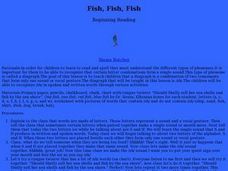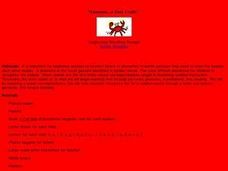Curated OER
Fish, Fish, Fish
Young scholars identify the digraph /sh/ in written and spoken language. After a brief discussion the independent and combined sounds of the phonemes /s/ and /h/ students practice identifying initial and final placement of the new...
Curated OER
Load the Boat To Travel the Moat
Learners discover that letters stand for phonemes. They determine that spellings map out the phonemes that are found in spoken words. They analyze the correspondence, oa = /O/ and recognize the /O/ sound in spoken and written words in...
Curated OER
Allie The Alligator
Students recognize the short vowel a in written and spoken language. Through listening activities, they discriminate the vowel sound /a/ from other phonemes. Students associate the phoneme with its letter representation and identify them...
Curated OER
Open Wide and Say Ahh
Pupils recognize the short vowel o in written and spoken language. Through matching and listening activities, they discriminate the vowel sound /o/ from other phonemes. Students identify the phoneme and letter in words and pictures.
Curated OER
"Aaaaaaa...a Fast Crab! "
Young scholars participate in an emergent literacy lesson plan that focuses on the skill of phonemic awareness. The phoneme chosen is the letter "a". They need to correlate the sound to the letter.
Curated OER
I Am Tired
First graders recognize the short vowel o in written and spoken language. Through listening and matching activities, they discriminate the vowel sound /o/ from other phonemes. Students associate the phoneme with its letter representation...
Curated OER
O-O-O-O-O, I get it!
Students engage in an emergent literacy instructional activity that focuses on the skill of phonemic awareness. To practice the skill the phoneme for the letter "o" is used. The students need to recognize the letter and its corresponding...
Curated OER
Shhhhh, the Baby's Asleep
Students identify the digraph /sh/ in written and spoken language. After a discussion of the independent and combined sounds of the phonemes /s/ and /h/ students practice identifying initial and final placement of the new digraph /sh/ in...
abcteach
Dragon Alliterations
You don't have to slay the dragon in this activity. Young writers review poetic devices with a set of worksheets about alliteration and similes. Once they finish waxing poetic about their dragon friends, they craft a final acrostic poem.
Curated OER
The Loud Trout Shouts!
Learners practice the strategies of phonemes and digraphs dealing with the correspondence "ou"=/ow/ in both spoken and written words. They listen as the book The Napping House by Audrey Wood is read to them and then they interact with...
Curated OER
Elmer the Elephant
First graders recognize the short vowel E in written and spoken language. Through matching activities, they discriminate the short vowel /e/ from other phonemes. Students associate the phoneme with its letter representation and spell...
Curated OER
Quack Attack
Students identify phonemes in words. They read and spell words that contain the /ck/ digraph. Students read the book Make Way for Ducklings. They practice reading and identifying words with the ck digraph while reading the story.
Curated OER
"OU" O U Hurt Me!
Students explore the digraph ou=/ow/ in written and spoken words. They practice writing words with the ou=/ow/ digraph. Students match phonemes in words they hear. Students read The Napping House and identify words with the ou=/ow/ digraph.
Curated OER
Eddie the Egg
First graders recognize the short vowel e in written and spoken language. Through matching activities, they discriminate the short vowel /e/ from other phonemes. Students associate the phoneme with its letter representation and identify...
Curated OER
Dinosaur Alliterations
In this alliteration worksheet, students review the definition and an example for alliterations. Students then write their own alliterations about dinosaurs and illustrate one of their examples in the box.
Curated OER
Adam's Apples
Students recognize the short vowel "A" in written and spoken language. Through matching and listening activities, they discriminate the short vowel /a/ from other vowel phonemes. Students associate the phoneme with its letter...
Curated OER
Ike's Ice Cream is Icy
Students recognize the short vowel i in written and spoken language. Through matching and listening activities, they discriminate the short vowel /i/ from other phonemes. Students associate the phoneme with its letter representation and...
Curated OER
Hop To It
Learners identify the grapheme and phoneme for H. They practice writing the letter H and through listening activities, discriminate the phoneme /h/. They associate the phoneme /h/ with its letter representation and identify it as the...
Curated OER
U-u-under The U-u-umbrella!
Students practice using phonemes because they need to be able to recognize that phonemes and letters correspond with each other in order to become a proficient reader. The practice is done using the letter "u".
Curated OER
What Did You Say?
Students recognize the short vowel E in written and spoken language. Through matching activities, they discriminate the short vowel /e/ from other phonemes. Students associate the phoneme with its letter representation and read pseudo...
Curated OER
Eddie the Elephant
Students need to practice sight words to become proficient readers. So it is very important for children to learn common correspondences. The phoneme for the letter "e" is practiced in this lesson.






















